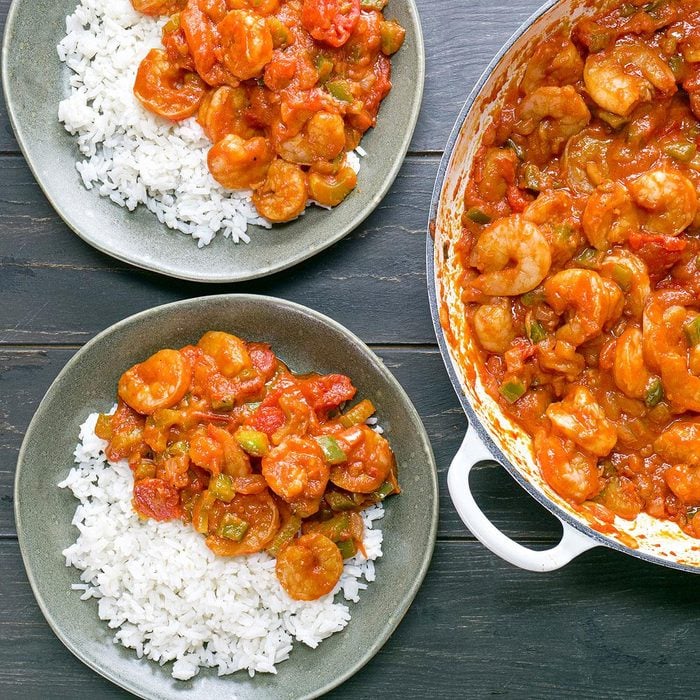Shrimp Creole combines some of the classic ingredients used in Creole cooking—shrimp, tomatoes and a deeply colored and flavored roux—into a thick sauce. Served over hot rice, it’s a filling meal full of aromatics and savory flavors. If your neighbors catch the aroma, they might just invite themselves over to supper.
And that’s just fine! This shrimp Creole recipe allows you to extend southern-style hospitality. One batch easily feeds six; have your friends and family (or hungry neighbors) bring a few southern side dishes, and you’ve got a fun community potluck.
What is shrimp Creole?
If you’re from the South, you probably draw a sharp line between Creole and Cajun food—and the best version of any dish in either category is the one you grew up with. Outside the region, that line has been so blurred that people use the terms interchangeably. But there are differences between Creole and Cajun food, and shrimp Creole highlights a few.
Crucially, there are tomatoes in this dish, an ingredient rarely found in Cajun recipes. This recipe calls for a light hand with the spices, which leans more Creole than Cajun. It also features shrimp, an ingredient more commonly served in coastal Creole communities than by Cajun cooks living in Louisiana’s inland bayous.
So, true to its name, shrimp Creole is almost always considered a Creole dish, even if you’re tempted to continue blurring the lines and spike it with tongue-tingling Cajun spices. This makes shrimp Creole stand out from other classic southern dishes like jambalaya, crawfish etouffee and shrimp gumbo. These started in one culture yet have been adopted by the other with distinctive twists, so you’ll find, for instance, both red (Creole) and brown (Cajun) jambalaya among our best jambalaya recipes.
Ingredients for Shrimp Creole
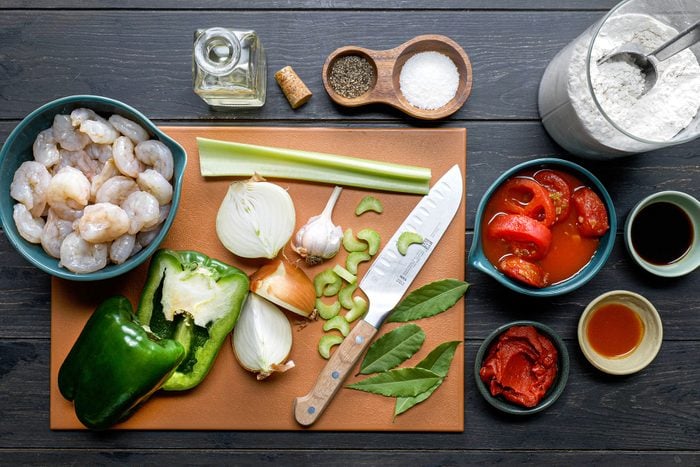
- Shrimp: If you lack access to fresh Gulf shrimp, use the best large shrimp you can find. Fresh or frozen are fine; if they aren’t already shelled and deveined, here’s how to clean shrimp yourself. Among the numerous types of shrimp found worldwide, white, brown, and pink shrimp all thrive in the South’s warm waters and are known collectively as Gulf shrimp.
- Roux ingredients: You make roux to thicken sauces and stews. It often starts with butter, but this recipe calls for canola oil because butter burns easily if you cook it too long. To get the deep-brown color and rich nutty flavor required for shrimp Creole, you need to cook flour in oil. A roux made with oil can cook for 20 minutes or longer over low heat.
- Onion, green pepper and celery: Called the Cajun holy trinity, these three vegetables support numerous Creole and Cajun dishes. Sauteing the vegetables in the roux blends their flavors into the rich base that defines this dish.
- Tomatoes: Cajun dishes rarely use them, whereas Creole ones often include them. Tomato paste helps thicken the shrimp Creole, while juicy stewed tomatoes intensify the flavor.
- Sauces: Worcestershire and hot pepper sauces add umami and just a little heat. Worcestershire sauce has a distinctive taste from fermented anchovies or sardines. Shrimp Creole favors flavor over heat and falls below the spiciness of, say, Cajun shrimp.
Directions
Step 1: Make the roux
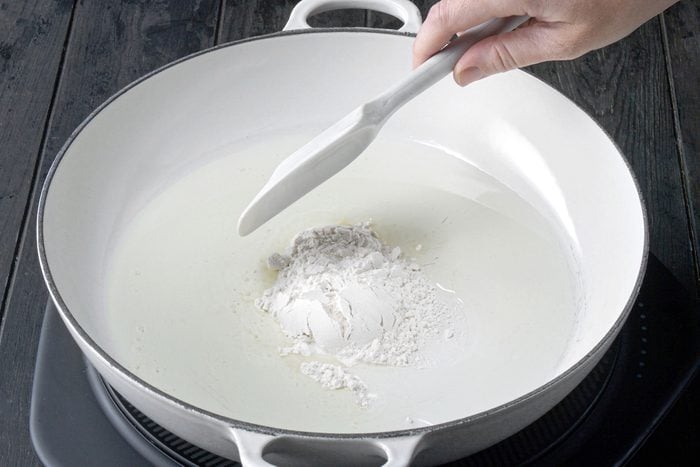
In a large heavy skillet, combine the flour and oil until smooth. Cook over medium heat, stirring constantly, until the flour is a rich deep brown.
Editor’s Tip: To get the right color, this could take up to 20 minutes. Be patient, and gauge as you go along.
Step 2: Add the Cajun holy trinity
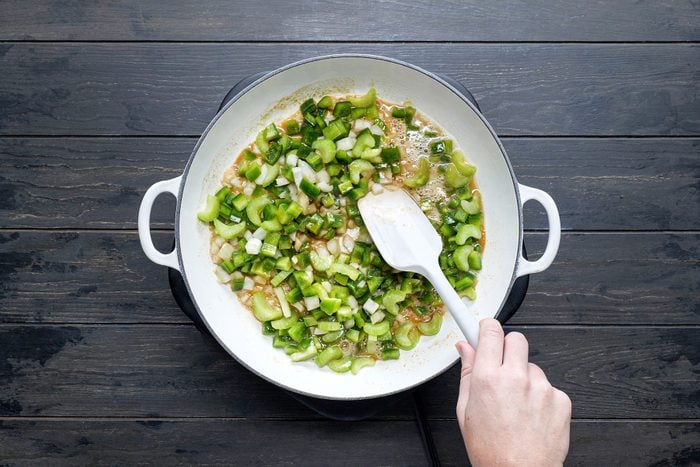
Add the onion, green pepper and celery to the roux. Cook, stirring often, until the vegetables are tender, five to six minutes. Add the garlic, and cook one minute longer.
Step 3: Cook the sauce
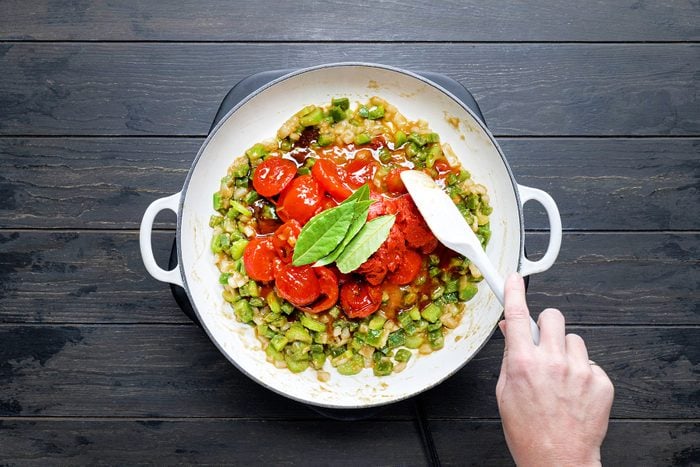
Stir in the stewed tomatoes, tomato paste, bay leaves, Worcestershire sauce, hot pepper sauce, salt and pepper. Cover the skillet, and simmer until the tomatoes are bubbly and the sauce is heated through, four to five minutes.
Editor’s Tip: When covered and simmered just until hot, this dish has the consistency of a thick soup. If you use juicier canned tomatoes or want a thicker sauce, let it simmer uncovered over low heat, stirring occasionally, for up to an hour.
Step 4: Cook the shrimp
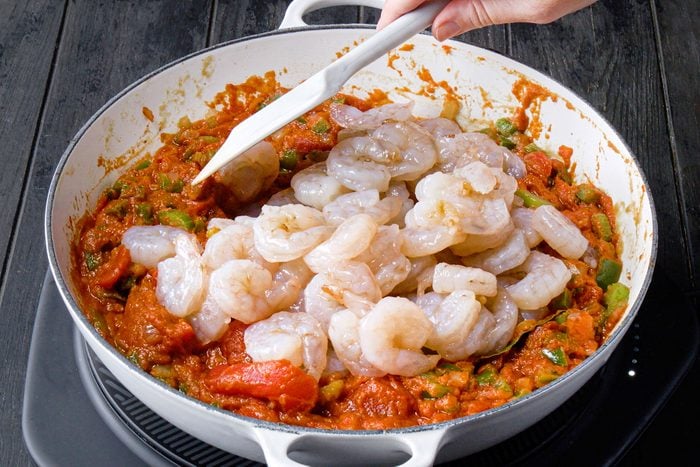
Add the shrimp. Simmer, uncovered, until the shrimp turn pink and are just cooked through, five to six minutes. Discard the bay leaves.
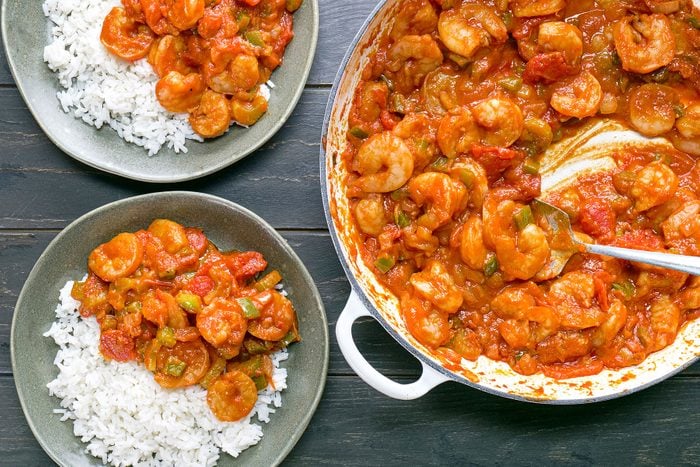
Serve the hot shrimp in sauce with rice.
Recipe Variations
- Mild vs. spicy: Your choice of hot sauce will define the overall spiciness of the dish, from a little lingering heat to a bold fiery kick. Traditionally, you would keep it fairly mild while cooking and set a bottle of hot sauce on the table for those who want to climb the Scoville scale.
- Dried herbs: Rub 2 teaspoons of dried basil, 1 teaspoon of dried thyme and 1/2 teaspoon of dried oregano between your palms to release their flavor, then sprinkle them on the sauce before letting it simmer. You can stir in 1/2 teaspoon of ground cumin, too, then adjust all of the seasonings to taste.
- Creole seasoning: A Creole seasoning mix made of dried spices and herbs gives you a versatile blend ready to use on everything from chicken to vegetables. Add 1/2 teaspoon or so at first, then taste the simmered sauce before stirring in more.
How to Store Shrimp Creole
A full batch of shrimp Creole might be more than your family can polish off in one sitting, but it keeps well—and tastes even better after the flavors have melded. Store the cooled sauce in an airtight container in the refrigerator for up to four days. Quickly cool any leftover rice, pack it into a separate container, and use it within four days.
If you know you’ll be eating shrimp Creole over a few days, put just enough shellfish into the sauce to divide among the first-night servings. When you reheat the sauce, bring it to a simmer over low heat and then add another round of fresh or defrosted shrimp to avoid rubbery twice-cooked ones. Make a fresh batch of rice each night or, if you want to reheat rice, make sure it comes to at least 165°F to reduce the risk of foodborne illness.
Can you make shrimp Creole ahead of time?
The tomato- and vegetable-filled sauce can be cooked ahead of time. It might actually taste best if, once cooled, you transfer it to an airtight container and leave it in the refrigerator overnight. The next day, simply bring it to a simmer and add the shrimp while you steam a separate pot of rice.
The sauce, without the shrimp, freezes well too. Store it in the freezer in an airtight container, with at least an inch of headspace, for up to three months. Thaw it in the refrigerator overnight before reheating, adding shrimp at the end. Previously frozen shrimp will lose texture and flavor if refrozen, and even fresh shrimp quickly turn tough when cooked, frozen and reheated.
Shrimp Creole Tips
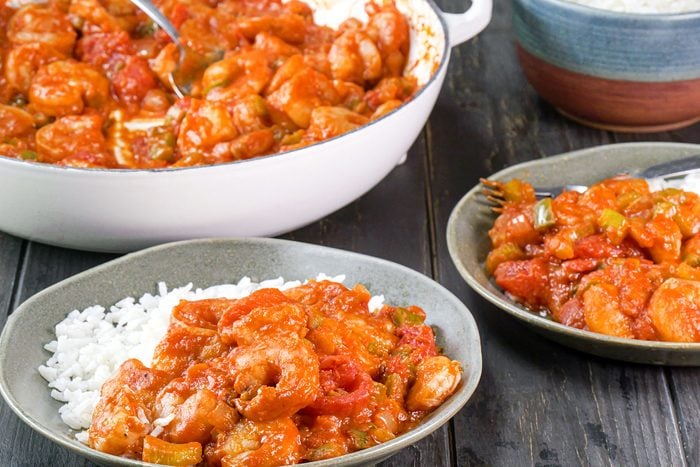
How do you peel and devein shrimp for shrimp Creole?
Live fresh shrimp make the best shrimp Creole, followed by frozen, thawed raw shrimp with the shell still on. Either choice means peeling and deveining the shrimp yourself. If the fresh shrimp still has a head, grip it in one hand and the tail in the other, and twist them apart. Starting at the head end, peel the shell back toward the tail, wiggling until the flesh comes free.
Some shell-on frozen shrimp is sold with the vein removed. You can remove it if intact by making a shallow cut along the shrimp back and teasing out the dark vein with a paring knife. Once you get your peeling and deveining skills down, put them to use in some of these other easy shrimp recipes.
How do you serve shrimp Creole?
Shrimp Creole is often served on a bed of fluffy white rice and a side of crusty bread. Instead of steamed white rice, try dirty rice. Shrimp Creole also makes a great topping for mashed potatoes. The dish is so filling that you can keep any sides simple, such as green salad or creamy coleslaw, green beans, corn on the cob or southern fried okra. For a larger spread, start with fried green tomatoes and end with New Orleans bread pudding.




















